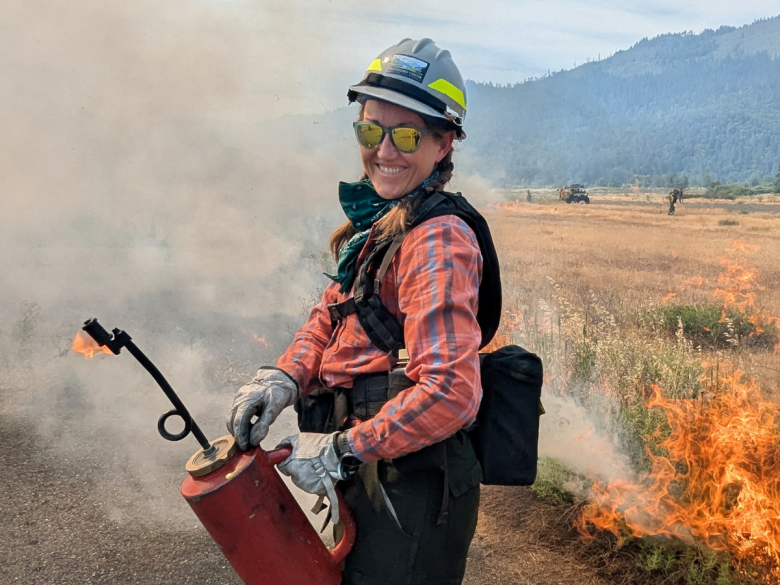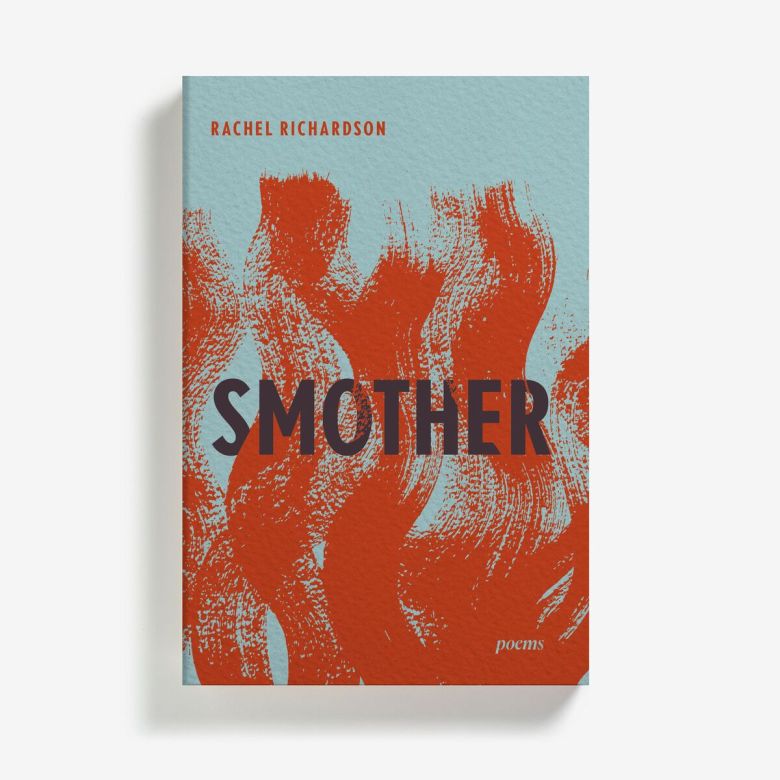 Berkeley poet and wildfire fighter trainee Rachel Richardson at a controlled burn at the regional airport in Hayfork, California, in June. Courtesy: Rachel Richardson
Berkeley poet and wildfire fighter trainee Rachel Richardson at a controlled burn at the regional airport in Hayfork, California, in June. Courtesy: Rachel Richardson
Poet Rachel Richardson’s new anthology, “Smother,” includes descriptions of the California wildfires of 2017-2022, parenting during the pandemic, the day the sky turned orange and the death of a close friend — like her, a mother of two — from cancer at the age of 39.
In this, her third book, Richardson brings readers along in her interrogations of grief and loss, motherhood and womanhood that waft through the poems, pointing out what we might have missed through all the smoke. In the end, she leaves us with a renewed appreciation for the relationships and worlds that have survived the pandemic and fires.
Several poems name-check Berkeley. In “Shut Down,” she says goodbye to “teenage babysitters, / the girl with razor scars on her arms / and the one in the crop top, / all juniors at Berkeley High.”
In “Tamarack Fire,” she writes about the helplessness she felt being “one hundred fifty miles away, 3 hours 18 minutes’ drive time in current traffic” from her two daughters, who were at Berkeley’s Tuolumne Camp. “I upload again and again / the little circles on the map/representing their air — / (my children in their tents —) / cursing when red turns/ to purple, praying to the god / I pray to, which is no god,/ which is the vast smoky sky,/ for orange, then yellow. Let me / be so bold as to pray/for green.”
As a consequence of the fires, Richardson recently added a unique entry to her bio: wildfire firefighter. Last year she began training as a crew level firefighter on track for a FFT2 certification, whose duties include fire suppression and fuel management.

A Berkeley native, Richardson returned in 2015 and now lives a half-mile from where she grew up in Thousand Oaks. In 2016, she and her husband, poet David Roderick, founded Left Margin LIT, a literary arts center and workspace in Berkeley that offers writing classes across the genres. She and her husband have two daughters, 12 and 14, whom Richardson refers to in her poems.
Richardson will participate in a Litquake event called “Writing About Wildfire” at 2 p.m. this Saturday, Oct. 11, at the Fairfax Library.
Richardson spoke with Berkeleyside about the inspirations and themes in her book, about wildfires and about how Berkeley is — and is not — the same place she grew up.
This interview has been condensed and edited for clarity.
Was the book inspired by one particular incident or was the motivation more cumulative and gradual?
What began the book was that one of my best friends, Nina Riggs, died at 39 of cancer and she has two children. Her memoir, “The Bright Hour,” was published posthumously. She had been sort of a parent mentor for me. I knew her when I lived in North Carolina for 10 years. Several poems are written to her, about her.
Why did you decide to train to be a wildfire firefighter?
After I finished the book in 2023, I felt like I needed to go out there and take actual action because fire is so physical. Poems are my favorite medium, they’re nice, but they don’t do things on the ground in a way that we can see. There was some sense of me that needed to get out there and put my boots on and do stuff with people, which also meant needing to get off the computer screen and reading about events from afar.
I don’t want to fight wildfires. I was really interested in changing my relationship to fire and feeling less victimized by it and thinking how we could live in a more symbiotic relationship with a landscape that needs to burn. There’s a lot of historical understanding about how humans have to treat the land in order to not have these kinds of devastating fires. Part of that is prescribed burning. For me as a writer, it was fascinating to learn this about the place I live and the ecology and also to participate in something that feels like a solution.
What does the training involve?
To get the designation you mostly take classes online through FEMA. Then you do a physical pack test and can go out and be on a crew. I’ve done the full training but have not gotten official certification, but I have been on burn crews. (If they’re not operated by the government, they don’t require certification.) I think I will still try to get it eventually, just to say I did, but I don’t really have to for any practical use in my desire to volunteer in prescribed fire. So far, I’ve been on a few prescribed burns, in Woodland and in Hayfork.
You grew up in Thousand Oaks and ended up living not far from your childhood home. How would you describe the changes to your hometown?
There was a real sense of the cooperative among many of the adults I grew up around. Everybody was making co-ops. A lot of that’s gone away and part of the reason might be that you don’t have free labor from the moms anymore, who stayed home or worked part time. In some ways, maybe it’s good that those changes have happened. But if no one has free time, how do you create the bigger sort of network of community support for kids and neighbors?
What’s stayed the same?
I have some neighbors on my block who have been here for 50 or 60 years. They are such repositories of story and that sense of strong community. These long-term neighborhood bonds and this sense of belonging to a place and loving that place is part of what drew me to my particular block and neighborhood.
The publisher’s description says that “these are not poems of giving up.” By the book’s end, you land on the side of hopefulness.
I try to end on the up note, which coincides with the chronological end of it in 2022-ish. We’re coming out of Covid. I write about my women friends who reaffirmed for me the importance of human connection during the pandemic. The last poem is about treeplanting with the Friends of Berkeley Tuolumne Camp. The landscape sometimes does burn and it’s devastating. And yet the earth is not over. You have to help it be what it can be next.
We know that most readers don’t get to the end of the article. But you did! To support our in-depth, rock-solid reporting, please consider making a donation to our nonprofit newsroom today. We rely on our readers — particularly the ones who read the whole story!
“*” indicates required fields

